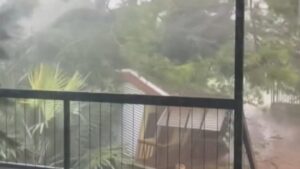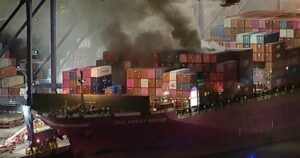
UPDATE: Goldfields miners are rapidly shifting focus from gold and rare earths to renewable energy, with significant new projects underway as the net zero debate intensifies. Amidst political turmoil over climate targets, miners are investing in renewable energy infrastructure that could power entire communities.
Northern Star Resources is leading the charge with plans for one of Australia’s largest behind-the-grid renewable power stations. This ambitious project near Kalgoorlie includes up to 32 wind turbines generating 256 megawatts of power, alongside a 120 megawatt solar farm to support its operations, including the ongoing $1.5 billion expansion of the Kalgoorlie Super Pit.
Speaking to reporters, Northern Star’s KCGM growth general manager Nick Strong emphasized the economic benefits: “It’s a good investment. It’s good cheap power, and the huge bonus is that carbon footprint reduction, so, win, win, win.” The project is currently under review by the environmental regulator, with expectations that it will lower operational costs significantly compared to existing grid prices.
In a similar move, South African miner Gold Fields is investing $296 million in a wind and solar project at its St Ives mine, aiming to cover around 70 percent of its energy needs. This includes a newly activated hybrid power grid featuring a 19 megawatt solar farm and a 40 megawatt gas plant, which could reduce reliance on fluctuating fuel prices.
Meanwhile, Lynas, a rare earths miner, has begun commissioning four large wind turbines that, combined with an existing 7 megawatt solar farm, could meet all operational energy needs on optimal days. Lynas anticipates that 70 percent of its electricity will come from renewable sources annually once the project is complete.
Despite the political landscape shifting—particularly with the WA Nationals abandoning their net zero commitments—no major mining company in Western Australia has publicly rescinded its goal for net zero emissions by 2050. Prominent mining figure Gina Rinehart has criticized these renewable initiatives, claiming they jeopardize shareholder dividends at major firms like Rio Tinto and BHP.
The ongoing debate among politicians has caused confusion, with Strong urging clarity from leaders regarding their positions on net zero and renewable energy impacts. “Are you denying climate change, or are you just objecting to the on-ground impact to your constituents?” he questioned. “Be clearer about what you’re concerned about would be my first message to them.”
As power costs and reliability become critical issues, miners are investing heavily in behind-the-meter renewable energy solutions. The Chamber of Minerals and Energy WA has highlighted a doubling in power costs for industrial customers on the South West grid since 2020, labeling it a significant barrier to further investment.
The drive for renewables is not just about environmental responsibility; it’s a pragmatic response to soaring energy prices. “We’re seeing lots of member activity in what we would call behind-the-meter renewable energy rollout because the pace of the grid-connected transition has been slow in Western Australia,” stated Anita Logiudice, policy and advocacy director at CMEWA.
As more projects come online, the Goldfields region is poised to become a leader in renewable energy generation, potentially transforming the local economy and energy landscape while contributing to broader climate goals. The situation remains fluid, with further developments expected as these projects progress and political discussions continue.
Stay tuned for updates as this story unfolds and the implications of these projects become clearer for the local and national landscape.





